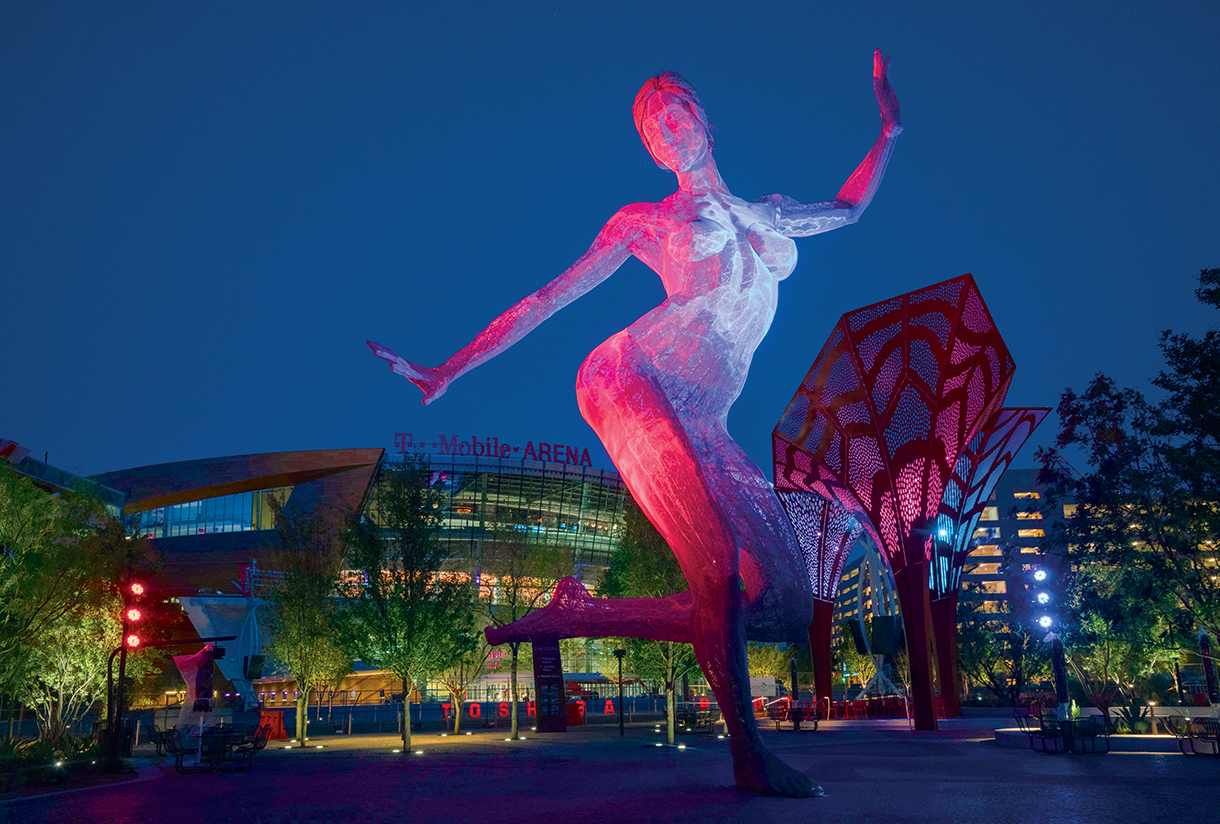
Viva Las Vegas
After suddenly shuttering in the spring, Sin City’s major resorts return with enticing amenities for a new era: poolside super cabanas, a beach town boardwalk–themed promenade, golf courses, tennis courts, private
gaming and dining rooms, and high-roller suites with VIP, no-contact services.
Fortunately for the city, many of the big changes of the past 20 years have also left Las Vegas better positioned as it moves forward into the new era of travel ushered in by the global coronavirus pandemic. While the outbreak initially shuttered the city’s tourism almost completely, and left reverberating ramifications that will change longtime local fixtures such as mega-buffets and live entertainment, many of the recent trends proved timely in addressing visitor concerns, especially the moves toward more private experiences, boutique lodging, and outdoor dining, entertainment, and recreation. Many of Vegas’ top hospitality providers have refocused on intimacy, privacy, exclusivity, and fresh air.
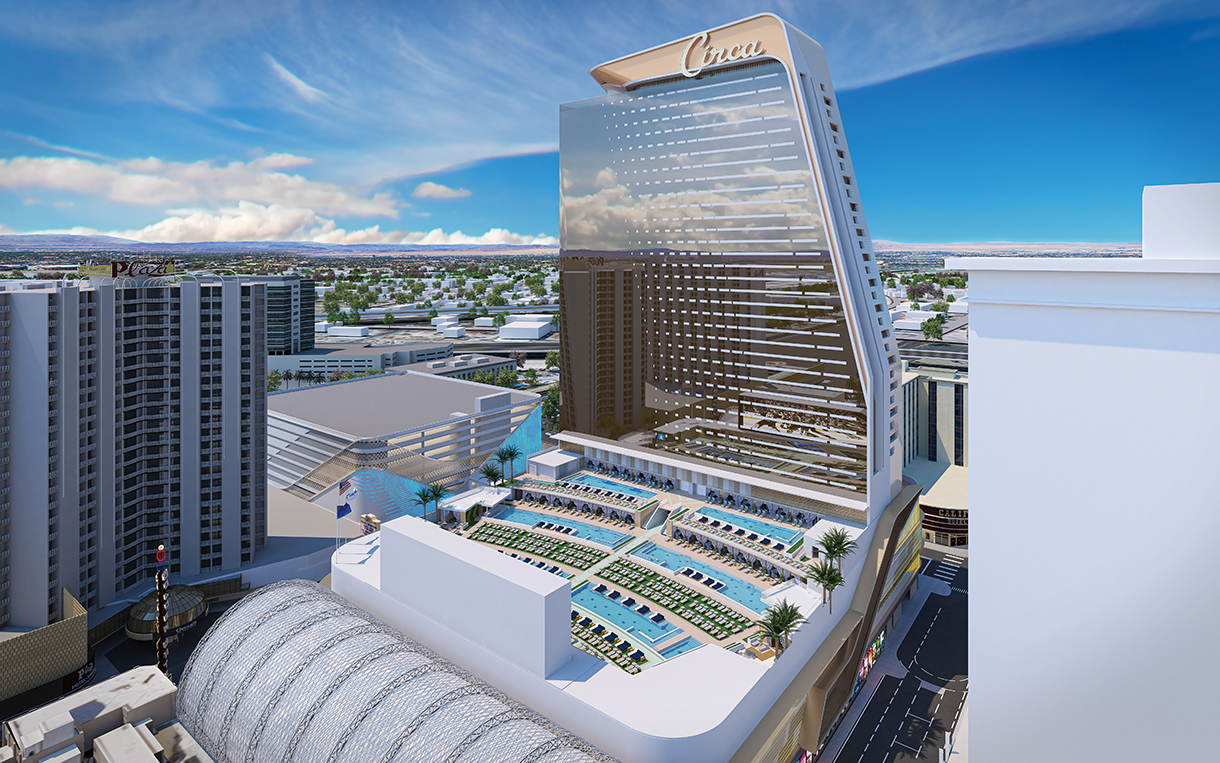
Consider that the first real outdoor poolside day club, Tao Beach at The Venetian, only debuted in 2007, and now the concept is an integral Las Vegas ingredient that has been replicated all over town. The city’s newest rooftop pool complex, atop the brand-new downtown Circa Resort & Casino, comes with six pools, “super cabanas” for up to 80 guests, and an outdoor drive-in theater-style 135-by-41-foot video screen.
“No one used to fly to Vegas to do yoga or take cooking classes,” says journalist Mike Hiller, who covers the city’s dining and hotel scene for the Los Angeles Times. “Las Vegas has its roots in gaming, but today placing bets only represents a small sliver of what drew more than 42 million visitors in 2019—another in a recent string of record-breaking tourism years. Prior to COVID-19, Vegas was also gaining traction as a top-tier destination for dining, live entertainment, spas, golf, pools, even driving exotic cars. With the recent addition of hometown NHL and NFL teams, Vegas remains positioned to deliver a far more powerful travel punch than two decades ago.”
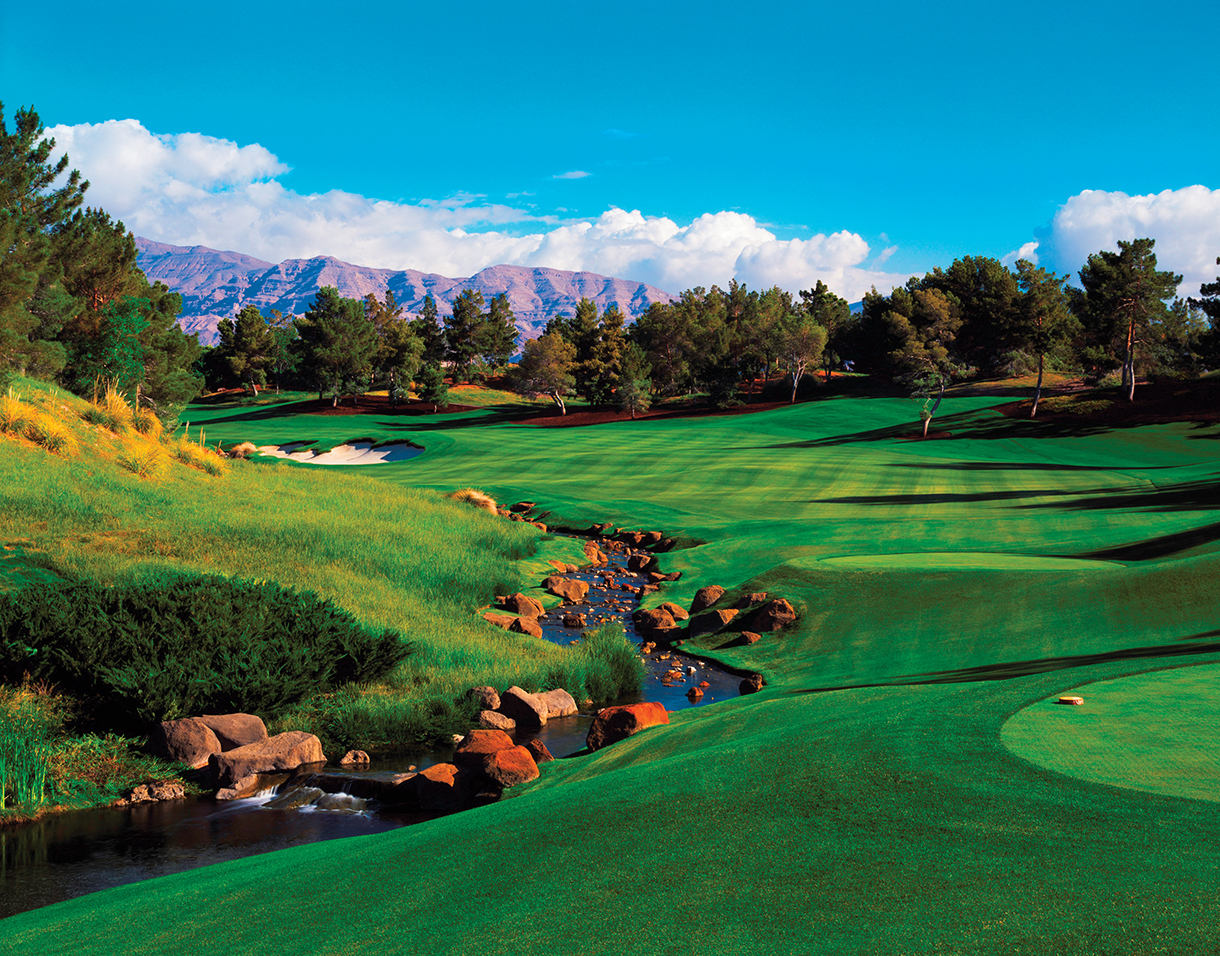
Nikodemus was on the opening team for City Center, MGM’s radical project that includes residences, two entirely non-gaming luxury hotels (Vdara and Waldorf Astoria), a shopping center, and tons of public art and sculpture, inside and out, creating a campus environment previously unknown in the often hermetically sealed city. As avoiding crowds becomes increasingly popular with visitors, several restaurants in Aria, the main City Center luxury hotel, feature private dining rooms that have seen extremely high reservations since the resort reopened from the pandemic closure, including Carbone, CATCH, and Jean Georges Steakhouse. Aria also has two boutique hotel options within it, the Tower Suites and the Sky Suites—both featuring private VIP check-in lounges, exclusive elevators, and private SUV airport transfers included in their room rates.

Now, at its 10-year anniversary, The Cosmopolitan is better than ever, having just finished a top-to-bottom renovation that redid every single room and added many new features, including four floors of new luxury penthouses. “Since the resort’s opening, we have undergone a complete redevelopment of every space unique to The Cosmopolitan, and we’ve seen the debut of 21 luxury Boulevard Penthouses and advanced technology featuring our resident chatbot, Rose,” says Patrick Nichols, general manager and chief strategic officer. Because The Cosmopolitan was developed as a condo project, not a casino, then converted to a resort hotel, even its regular rooms are larger and more residential, outshining other standard hotel offerings. As guests increasingly embrace fresh air, The Cosmopolitan is notably the only Strip property with open terraces in its regular rooms and suites (more than 70 percent). Its two-story Lanai Suites have an island beach house theme, private outdoor spaces with heated plunge pools, and direct access to The Chelsea Pool. The three-story Bungalow Suites have outdoor living spaces including terraces with Jacuzzi plunge pools and outdoor kitchens and bars.
High rollers love the Boulevard Penthouses, 21 ultra-luxury residential units with access to a private, high-limit gaming area called The Reserve. They were added to the formerly empty top four floors at a cost of $75 million. Several include extras like private treatment rooms and saunas, but for those in other Cosmopolitan lodgings, the hotel’s Sahra Spa, Salon, & Hammam offers its own Spa Suites that allow guests to skip shared amenities commonly found in locker rooms—each suite includes a steam room and shower, dual deep-soaking Jacuzzi tubs, and relaxation space.
In this vein, 10 Cosmopolitan restaurants have private dining options, and the resort will soon announce a new venture that will continue to expand on its approach of dynamic, first-to-market restaurant concepts. Al fresco meals have long been hard to come by in Las Vegas, but there are now more than ever. The combined Wynn and Encore resorts lead the pack with six fine-dining and two casual options that offer full-service outdoor seating, while Bellagio has two spots with lakeside terraces, including the new Las Vegas location of longtime Wolfgang Puck favorite Spago. Several new casual bars and restaurants with outdoor seating have opened in the city’s two recent pedestrian promenade additions, instantly popular nods to classic beach town boardwalks and revolutionary for Las Vegas: the LINQ Promenade and The Park.
Privacy and the outdoors are the two hottest commodities in town these days, and The Cosmopolitan offers both in spades. It has one of the only outdoor tennis courts on the Strip, and three distinct pool experiences, the Boulevard Pool, Chelsea Pool, and Pool Marquee, each with luxury cabanas, reserved daybeds, and poolside food and beverage service. Most top hotels, including Bellagio, Aria, MGM Grand, Mandalay Bay, The Mirage, Wynn, Encore, and Caesars Palace also have private poolside cabanas available, as do the smaller and more intimate pools at the Four Seasons and Waldorf Astoria. Aria’s luxury Sky Suites boutique hotel has its own guest-only pool, also with reserved cabanas and daybeds. All have extensive food and beverage service, and the Bellagio is offering massages and spa treatments in its poolside cabanas.
While few visitors know about them, indoor/outdoor accommodations like those at The Cosmopolitan can now be found at several top properties. These are large enough for families or groups of friends traveling together, a big current trend, perfect for hunkering down, eating in, and most have special access to exclusive intimate gaming areas. The Villas at The Mirage are comprised of just 14 units from 1,800 to 8,500 square feet, all at ground level, with substantial grassy backyards and outdoor living spaces, including open-air dining, weatherproof televisions, and plunge or full-size pools. Some add hot tubs, outdoor kitchens, gas firepits, and even putting greens.
Nobu Hotel within Caesars Palace offers its flagship David Rockwell–designed rooftop Nobu Villa, which starts at $35,000 nightly and offers 360-degree views. The three-bedroom, 10,300-square-foot villa has its own elevator from the lobby and extensive outdoor areas including a Zen garden with an outdoor whirlpool tub and full outdoor kitchen with a Robatayaki grill and pizza oven. Skylofts is a 51-suite boutique hotel on the top two floors of the MGM Grand. All units are two-story residential apartments designed by Tony Chi, but the largest have patios with outdoor hot tubs.
Wynn has a dozen one- and two-bedroom Fairway Villas, with large patios along its golf course—the only one on the Strip and a gem just rebuilt by legendary designer Tom Fazio. It joins Shadow Creek (also by Fazio) as the city’s top luxury golf options, while for less serious players, the MGM Grand added the world’s largest Top Golf facility, multilevel and outdoors with open-air dining and its own pool cabanas.
Las Vegas has always been about reinventing itself in ever more popular ways, and a major 21st-century change has been encouraging guests to go outside. For decades, the strategy of resort operators was to keep guests captive in order to capture their wagering dollars. But as wagering became a less important component of the city’s tourism economy, millions of dollars have been spent to make the city more accessible by foot and appealing to those actually leaving the mega-resorts, with new sky bridges, escalators, parks, and promenades. Following the popularity of the new street-front Eataly at the Park MGM resort, the city last year opened its 17th pedestrian bridge across Las Vegas Boulevard—all built since 1995. For the new Allegiant Stadium, home of Las Vegas’ NFL team, the Raiders, there are plans to close Hacienda Avenue to traffic to facilitate walking over the interstate to attend games.
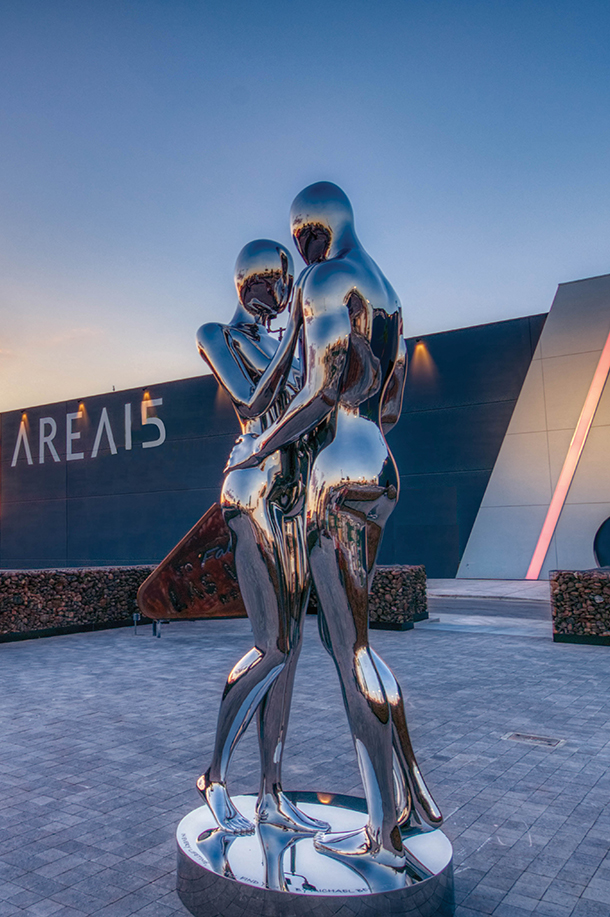
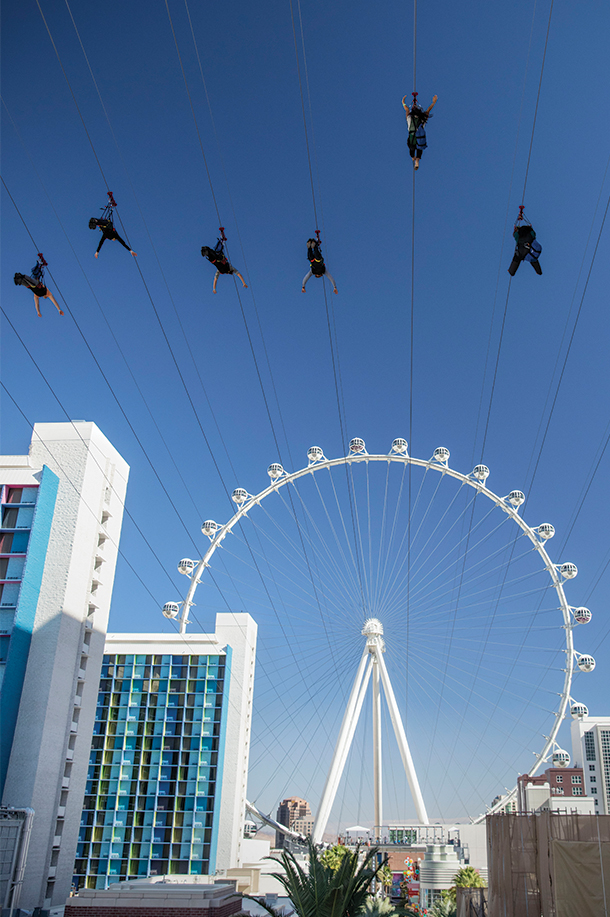
Downtown’s premier outdoor attraction, the pedestrianized Fremont Street Experience, just got a $32 million upgrade to its video screen (the world’s largest), and the impressive Neon Museum, established in 1996, is almost entirely outside. Two of the city’s biggest hospitality players, MGM and Caesars, built lively outdoor retail, dining, and entertainment districts, The Park and the LINQ Promenade, with al fresco dining and outward-facing bars, restaurants, shops, and entertainment, including the immediately iconic High Roller Observation Wheel and the new FLY LINQ Zipline.
“As customer interests have evolved over the years, Caesars Entertainment has been an industry leader in reinventing Las Vegas,” says Gary Selesner, regional president. “There is no other location on the Strip where families and adults can enjoy all these diverse experiences in one place, with the added ambiance of an open-air promenade. Our outdoor concept has proven to be successful, with others following our lead in recent years.” As Vegas enters the 2020s, there will be even more outdoors, more privacy, more creativity. After all, excess has always been what Sin City is all about.




